History
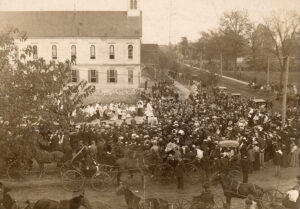 In 1884, Bishop Edward Fitzgerald of the Diocese of Little Rock granted permission for the increasing population of German speaking Catholics in the Diocese to establish a new parish, donating three lots at East Ninth and Sherman Streets for construction of a church building, across from what is now known as MacArthur Park and the Arkansas Museum of Fine Arts. The Benedictine Fathers of Subiaco Abbey had been administering to the German Catholics in Little Rock since 1878, and so were assigned to pastor the new parish, named St. Edward Catholic Church in honor of Bishop Fitzgerald.
In 1884, Bishop Edward Fitzgerald of the Diocese of Little Rock granted permission for the increasing population of German speaking Catholics in the Diocese to establish a new parish, donating three lots at East Ninth and Sherman Streets for construction of a church building, across from what is now known as MacArthur Park and the Arkansas Museum of Fine Arts. The Benedictine Fathers of Subiaco Abbey had been administering to the German Catholics in Little Rock since 1878, and so were assigned to pastor the new parish, named St. Edward Catholic Church in honor of Bishop Fitzgerald.
The construction of the original church building was completed in 1885 with a final cost around $9,000. The frame building was two stories high, with the church on the second floor and a school, staffed by the Benedictine Sisters of St. Scholastica Covent, on the first floor. The building also housed the pastor.
Among the parish organizations formed early in the life of the parish, the St. Edward Christian Mothers’ Sodality was established in 1885, eventually affiliating with the Archconfraternity of Christian Mothers in 1887. The Mothers’ Sodality, concerned chiefly with the spiritual welfare of its members’ families, has existed continuously at St. Edward since that time and is still functioning today.
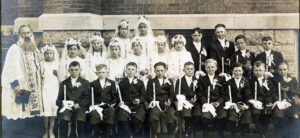 As the parish grew, additional lots were purchased until the parish encompassed the entire city block on which the church building stood. Over the ensuing years, the property would include the church building, a school building, a convent for the Benedictine Sisters, and a rectory for the pastor. As the parish outgrew the original church and school building, plans were made to erect the existing church, with the cornerstone being laid in 1901. The new church, designed by notable Arkansas architect, Charles Thompson, was dedicated with a five-day celebration in 1905.
As the parish grew, additional lots were purchased until the parish encompassed the entire city block on which the church building stood. Over the ensuing years, the property would include the church building, a school building, a convent for the Benedictine Sisters, and a rectory for the pastor. As the parish outgrew the original church and school building, plans were made to erect the existing church, with the cornerstone being laid in 1901. The new church, designed by notable Arkansas architect, Charles Thompson, was dedicated with a five-day celebration in 1905.
In January, 1964, the church building was severely damaged by a fire believed to have been caused by faulty wiring near the Our Lady of Perpetual Help shrine. The main altar was destroyed, the organ was damaged, several stained-glass windows were ruined, and there was significant destruction to the sacristy, the sanctuary, and the basement beneath the church. The church was closed for over a year while restoration was completed, reopening in April, 1965, with a near replica of the destroyed 30-foot altar having been built in Germany and shipped across the Atlantic in 36 separate crates. In 1982, St. Edward Catholic Church was included on the National Register of Historic Places.
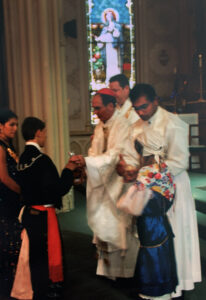 In 1992, the Benedictine priests who had served the parish as pastors from its beginning were replaced by diocesan priests, and the last two remaining Benedictine Sisters retired from the school. At about the same time, St. Edward began its ministry to the Spanish speaking Catholics in the Little Rock area. That ministry continues today with a large Spanish speaking congregation being part of the St. Edward Parish family. As a result, new customs and feast days, such as the feast of Our Lady of Guadalupe, have taken on prominence at St. Edward.
In 1992, the Benedictine priests who had served the parish as pastors from its beginning were replaced by diocesan priests, and the last two remaining Benedictine Sisters retired from the school. At about the same time, St. Edward began its ministry to the Spanish speaking Catholics in the Little Rock area. That ministry continues today with a large Spanish speaking congregation being part of the St. Edward Parish family. As a result, new customs and feast days, such as the feast of Our Lady of Guadalupe, have taken on prominence at St. Edward.
Also in 1999, after decades of neglect, there was increasing awareness of the need for a capital campaign to support the restoration of the church building. As part of the parish Master Plan, the ROSE (Restoration of St. Edward) committee was established to oversee the fundraising and assist with the decision making for the repair and restoration of the church. The church building was closed in October, 2001, the doors being sealed by Bishop Peter Sartain, and the restoration begun. Six months later the wonderfully restored church was reopened over Easter weekend of 2002. The cost of the restoration was about $650,000.
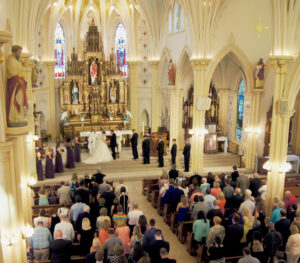 In 2004, in the next phase of the Master Plan for the parish, titled “Built of Living Stones,” fundraising and plans were begun for the erection of a new school building. Groundbreaking was held in May, 2006, and the new building was completed in October, 2007. The Quapaw Quarter Association presented St. Edward its 2008 Little Rock Preservation Award in recognition of the historically compatible design, scaling and structural elements of the new school building. Sadly, in 2019, after rendering 134 years of Catholic education, St. Edward School closed due to financial difficulties.
In 2004, in the next phase of the Master Plan for the parish, titled “Built of Living Stones,” fundraising and plans were begun for the erection of a new school building. Groundbreaking was held in May, 2006, and the new building was completed in October, 2007. The Quapaw Quarter Association presented St. Edward its 2008 Little Rock Preservation Award in recognition of the historically compatible design, scaling and structural elements of the new school building. Sadly, in 2019, after rendering 134 years of Catholic education, St. Edward School closed due to financial difficulties.
Fortunately, however, new uses were found for the school building. Briefly, St. Edward operated its Early Learning Center for preschool age children in the school. Eventually, the school building was transformed into the highly successful St. Edward Thrift Store and Gift Shop. The Thrift Store is operated and staffed by volunteers and has grown increasingly popular among parishioners and others across the central Arkansas area.
In 2023, St. Edward Parish was honored to have been designated by Bishop Anthony Taylor as the Diocesan Shrine of the Divine Mercy. The Shrine, located in the south transept of the church, was dedicated on June 11, 2023.
Liturgy, Music and Stained Glass
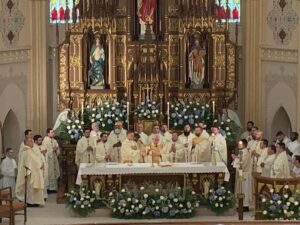 St. Edward Church is a Catholic community of believers, rich in tradition and growing in diversity. Recognizing the equality of all persons in the eyes of God, we provide an atmosphere in which parishioners of all ages and cultures share faith through sacramental and liturgical celebrations and other social and spiritual events which enable us to connect our faith with the world in which we live and lead our members to eternal salvation.
St. Edward Church is a Catholic community of believers, rich in tradition and growing in diversity. Recognizing the equality of all persons in the eyes of God, we provide an atmosphere in which parishioners of all ages and cultures share faith through sacramental and liturgical celebrations and other social and spiritual events which enable us to connect our faith with the world in which we live and lead our members to eternal salvation.
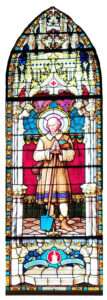 The musical arts have a profound impact on the parish’s many liturgical celebrations throughout the year. The original W. Kimball Organ was rebuilt in 1986 and included rearranging the pipes so that parishioners could see the beautiful rose window. This magnificent pipe organ accompanies weekend liturgies, weddings and other feasts and solemnities. There are two choirs (Spanish and English) who sing at Mass on the weekends and during the principal solemnities of the liturgical year.
The musical arts have a profound impact on the parish’s many liturgical celebrations throughout the year. The original W. Kimball Organ was rebuilt in 1986 and included rearranging the pipes so that parishioners could see the beautiful rose window. This magnificent pipe organ accompanies weekend liturgies, weddings and other feasts and solemnities. There are two choirs (Spanish and English) who sing at Mass on the weekends and during the principal solemnities of the liturgical year.
Visually, the church’s art is breathtaking; from the colorful stained glass windows to the detailed Stations of the Cross carvings. Most of the work was done in Germany and imported. The stained glass windows have a Beuron art design, which tends to make the features of all personalities very delicate, smooth and not at all severe or unnatural. These windows portray biblical events and saints and have the name of the parish sponsor at the bottom of the window. Of interest is the fact that the windows on the south wall feature male saints while those on the north side are of females. This is in keeping with the tradition in the parish at the turn of the 20th Century for women to sit on one side of the church and men on the other. Currently the parish is undergoing a campaign to repair and restore the areas around the windows.

